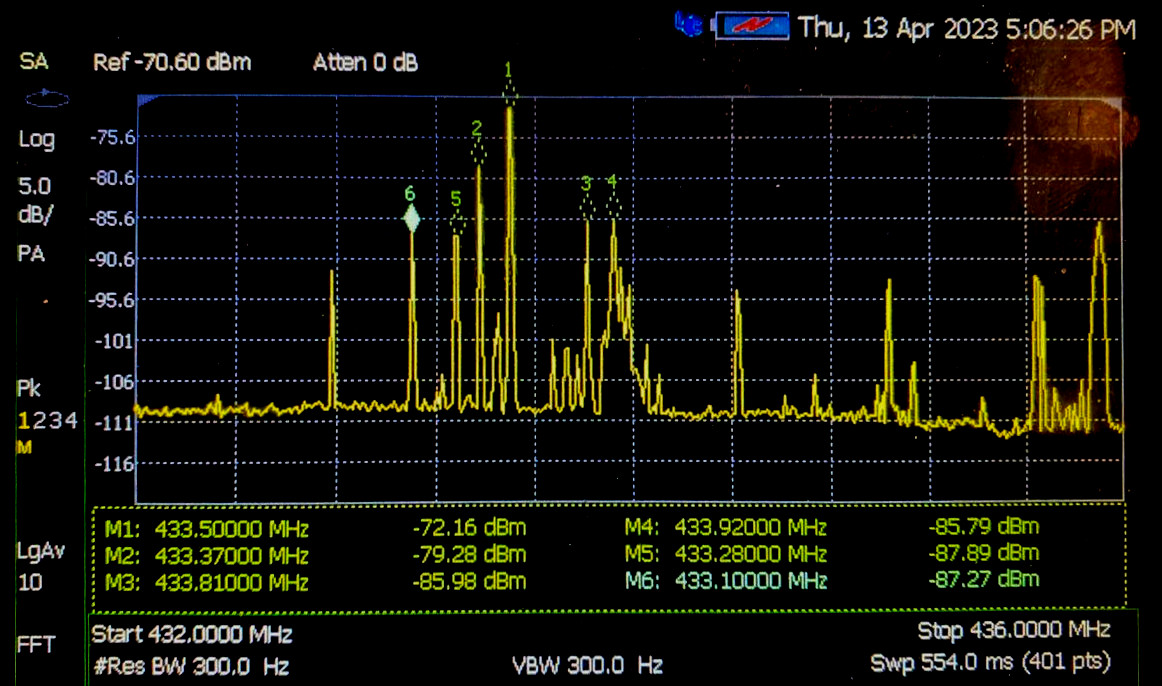Why 438 MHz
Uplink
In many ITU Region 1 countries, the ISM‑band extends from 433.050 to 434.790 MHz. Amateur radio services of these countries operating within this band must accept harmful interference which may be caused by these applications, as noted in the ITU amateur footnotes. A similar situation exists in the other ITU regions, see Figure 1.
To protect weak uplink signals from this ISM interference, 438.050–438.175 MHz was selected as the APRS 438 uplink spectrum. This use is compliant with the IARU Region 1 UHF band plan.
Distance is also kept from Austrian POCSAG on 438.025 MHz and most of the Austrian 70 cm repeaters, with the exception of a handful of AFSK digipeaters.

Figure 1 The ISM‑band spectrum in Santiago de Chile, a metropole with seven million inhabitants.
Downlink
The default downlink spectrum is 439.550–439.675 MHz. This is compliant with the IARU Region 1 UHF band plan.
Alternative Downlink
The default downlink spectrum is problematic in at least two countries:
In The Netherlands, amateur radio has no primary status in the band segment 436–440 MHz.
In Austria, the band segment starting from 439.100 MHz is receive only.
To deal with these limitations, an alternative downlink spectrum is suggested: 434.425–434.550 MHz.
This is bandwidth-wise not compliant with the IARU Region 1 UHF band plan, but is still within a band segment reserved for digital communications. However, in these countries the IARU Region 1 band plan is not upheld anyhow.
Attention
The alternative downlink spectrum is only intended for those countries where amateur radio is not allowed to transmit (e.g. Austria) or has secondary status (e.g. The Netherlands) on the preferred downlink spectrum. Terminal-type end devices will expose an option to select the alternative downlink.
I‑gates using the alternative downlink spectrum are fervently advised to emit at higher power levels (e.g. 7.5 W) to overcome the interference caused by ISM systems.
ITU Regulation
From an International Telecommunication Union (ITU) regulatory point of view, long range communication —which, by definition, includes LoRa (= “Long Range”)— is not allowed on ISM (Industrial, Scientific & Medical) bands. ISM bands are intended for local use only.
The amateur radio service forms a sole exception to this, as its 70 cm UHF band happens to overlap the ITU Region 1 433–435 MHz ISM band. In most countries, amateur radio as a primary service over most of the 70 cm band. Moreover, ham radio is not restricted to a 20 dBm (= 100 mW) power level, nor any 1% duty cycle limits on this band.
Tip
The modulation gain of LoRa over FSK is about 10 dB in the link budget. By consequence, a 10 W AFSK packet link could be replaced by a 1 W LoRa link.
Caution
As a general rule, secondary users should always check whether a frequency is in use by a primary user before transmitting on air. However, LoRa has no carrier sensing capability. Therefore, secondary (ISM) band users lack the ability to check whether a primary service is using the 70 cm band.